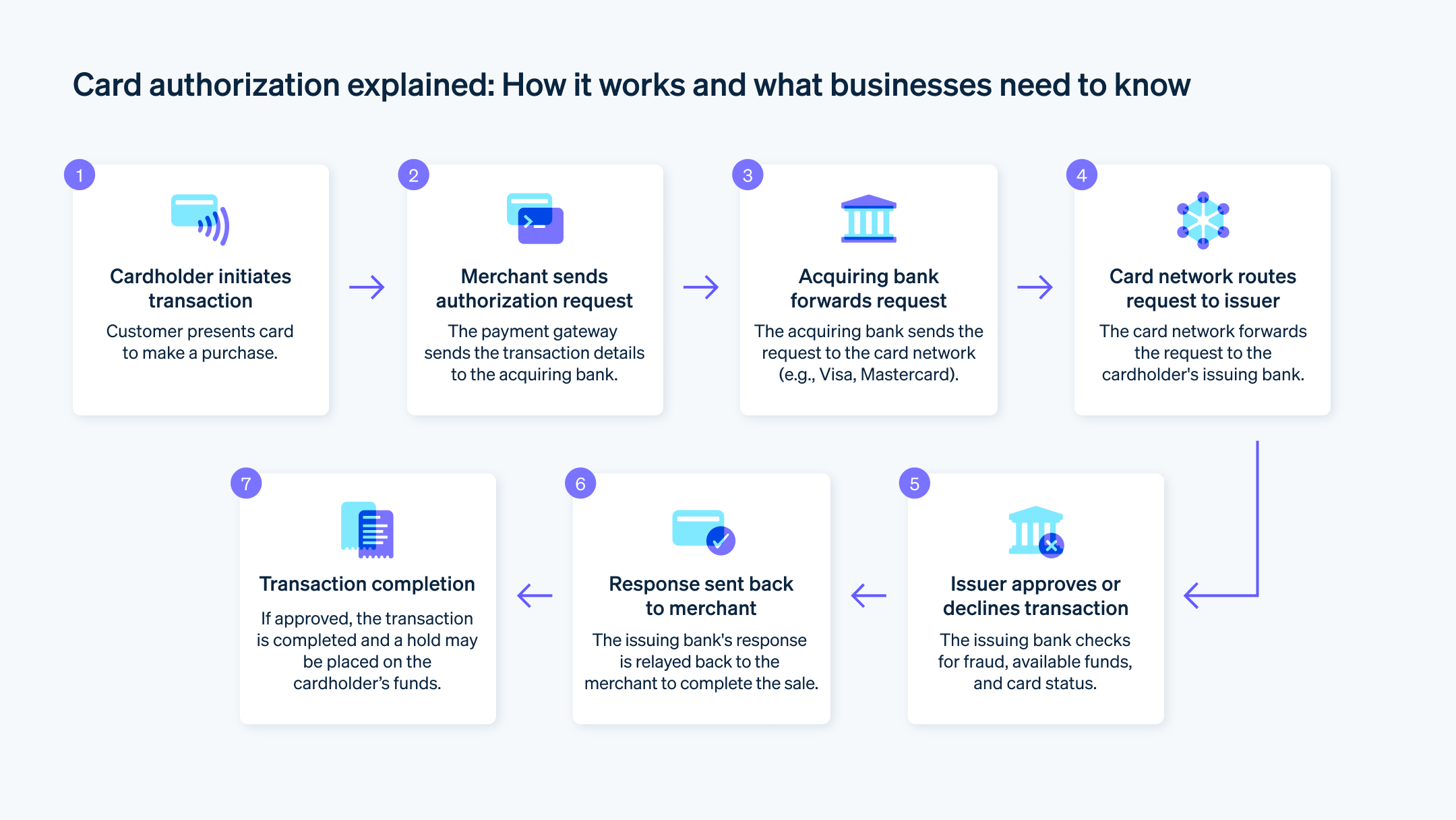如果您曾经使用过信用卡或借记卡进行购物,那么您已经参与了银行卡的授权流程。如果您的企业接受客户的信用卡和借记卡付款,情况也是如此。全球每天处理超过 10 亿笔信用卡交易,所有这些交易都需要授权才能完成。但是,尽管这是大多数人日常生活的常规方面,也是开展业务的关键环节,但大多数人对卡授权流程知之甚少。
银行卡授权远比简单地检查持卡人是否有足够的资金完成消费要复杂得多,影响也大得多。此过程是一项强大的安全措施,它为发卡机构和企业提供了一种常规方法,在交易成功之前筛查潜在的欺诈行为。作为企业主,了解银行卡授权是如何运作的,以及为什么有些授权会失败,将有助于您开展业务,为客户提供最顺畅的交易体验。
目录
- 什么是银行卡授权?
- 银行卡授权如何运作?
- 什么是捕获?
- 什么是结算?
- 什么是信用卡授权表?
- 信用卡授权表安全吗?
- 什么是银行卡预授权?
- 为什么银行卡授权会失败?
- 安全原因
- 经济原因
- 技术原因
- 安全原因
什么是银行卡授权?
银行卡授权是信用卡或借记卡发卡机构(通常是银行或信用合作社)的批准,表明持卡人有足够的资金或可用信用额度来支付他们使用信用卡完成交易的费用。
从某种意义上说,“银行卡授权”一词可以指授权本身,例如,“我们有此次购物的银行卡授权”。它也可以表示寻求授权的过程,例如,“我们现在正处于银行卡授权的中间阶段。”
银行卡授权如何运作?
在我们进入银行卡授权的实际过程之前,我们先快速了解所有涉及的关键参与者。银行卡授权涉及四方:
- 客户,在此上下文中通常称为持卡人
- 企业
- 发卡机构或发卡行
- 收单机构或收单行
银行卡授权通常通过支付处理商 完成,作为他们为企业提供的服务范围的一部分。许多支付处理商在支付处理方面为企业扮演着多种角色,包括充当企业的收单机构。例如,Stripe 为企业提供支付处理,以及企业账户和收单机构的功能。收单机构(也称为收单行)是代表企业处理信用卡或借记卡付款的银行或金融机构,特别是在与持卡人的银行(称为发卡机构或发卡行)沟通以授权交易时。
以下是所有这些方相互沟通以批准(或不批准)交易的流程:
- 客户在销售点出示一张卡进行付款。线上和线下交易都需要银行卡授权。
- 企业的销售点 (POS) 软件会自动向其支付处理商或收单机构发送请求,要求他们授权交易。
- 收单机构将接受请求,并通过卡组织将其发送给发卡机构,请求批准。
- 发卡行会审查持卡人的账户,以检查以下两点:
- 确保卡本身有效
- 确保有足够的资金或信用来支付购买成本
- 确保卡本身有效
- 发卡行将向收单行返回以下两个决定之一:
- 使用授权代码批准:如果发卡机构方面一切正常(该卡有效且有足够的可用资金),则发卡机构会响应收单机构的请求,批准交易继续进行。此批准将附有授权代码。
- 被拒绝,并显示错误代码:如果发卡行确定交易无法获得授权(我们将在一分钟内介绍可能的原因),他们将通知收单机构并发送错误代码。
- 使用授权代码批准:如果发卡机构方面一切正常(该卡有效且有足够的可用资金),则发卡机构会响应收单机构的请求,批准交易继续进行。此批准将附有授权代码。
银行卡授权流程通常只持续几秒钟。想想从您提交银行卡付款到读卡器显示“已批准”之间的短暂时间 — 上述流程中的所有步骤都是在这几秒钟内完成的。

什么是捕获?
当企业收单机构要求从发卡账户发送授权资金时,就会发生银行卡支付流程的捕获阶段。在银行卡授权期间,发卡机构会确认是否有支付消费所需的资金或信用额度,但在授权过程中资金本身并不会移动。这发生在捕获之后。付款捕获时间可变,但由于大多数银行卡授权在 5-10 天内失效,因此大多数企业及其支付处理商都会在此之前捕获资金。
什么是结算?
结算是指客户交易的资金实际从持卡人的发卡行转移到企业的收单行。可以这样想:
- 付款授权是指发卡机构说:“是的,这些资金可用并被批准用于此次购买。”
- 捕获是指企业收单机构说:“好的,太好了,请把资金汇给我们。”
- 结算是指资金实际从发卡账户转移到企业账户。
这里有一个真实的例子有助于澄清这一点:比方说,您下单购买食品杂货送货上门。您所使用的应用会将所选商品的预估费用、预估税费和司机小费相加。在订单完成之前,该应用不会知道确切的总金额,但它需要事先获得发卡机构的授权,以确保您有足够的可用资金或信用额度来支付这笔费用。当您首次下订单并提交您的银行卡信息进行付款时,应用(或者更确切地说是应用的收单机构或支付处理商)将联系发卡银行,请求授权支付您的订单预计总金额,该金额可能会略高于实际总金额。如果您的银行卡发卡行授权进行交易,您的银行卡将被扣留该金额。在交易实际完成后,应用程序知道了您订单的最终金额,他们就会要求获取该金额。这个过程类似于在预订酒店时使用信用卡来支付杂费,酒店会在卡上扣留一定金额,但在结账时只向您收取消费金额。
什么是信用卡授权表?
信用卡授权表是客户(或持卡人)填写的一份文件,允许企业从其信用卡中扣款。信用卡授权表更常用于大额消费(如汽车、电脑等),而非小额日常用品。它们也常用于设置新订阅和其他经常性付款。有时信用卡授权表是以数字方式生成的;有时是打印出来的。通常,企业会在以后持卡人不在场的情况下实际从信用卡中扣款时使用这些表格。
此类表上的信息必须包括:
- 持卡人姓名
- 卡号
- 卡组织(Visa、Mastercard、美国运通、Discover 等)
- 银行卡到期日
- 持卡人的账单邮政编码
- 公司名称
- 授权收费的声明
- 持卡人的签名和签名日期
此外,许多信用卡授权表包含以下部分或全部信息:
- 持卡人的完整账单地址和送货地址
- 持卡人的电话号码
- 持卡人的电子邮件地址
- 企业联系信息
- 购买金额
- 规定此批准用于经常性付款的语言(如适用)
- 购买所涵盖的商品或服务的详细信息
- 客户 ID、发票或采购订单号
信用卡授权表安全吗?
信用卡授权表的安全性完全取决于企业采取的保护措施。例如,通过 DocuSign 等第三方网站的数字信用卡授权表经过严格设计,尽可能安全。相反,当您处理打印出来的模板表单时,表单上敏感信息的安全性取决于持卡人填写表单后企业如何处理表单及其包含的信用卡信息。
什么是银行卡预授权?
当发卡机构审核交易的授权请求时,如果有足够的资金来支付销售成本,发卡机构将对持卡人的账户进行预授权。这将使他们的可用资金或信用额度减少销售金额,以防止他们在当前交易的资金转移并发送到企业银行之前可能透支账户。预授权是防止银行卡欺诈和拒付的有用机制。
例如,如果某人的信用额度上有 300 美元的可用资金,他们以 260 美元的价格购买了商品,并且在该交易获得批准后,他们的卡上没有预授权,那么他们就可以在第一次购买的 260 美元从他们的账户中转出之前以 100 美元的价格快速购买其他商品。当所有交易都结算完毕时,它们将超出限额 60 美元,这对发卡行和持卡人来说都不是理想的情况。预授权是发卡机构确保持卡人账户立即反映其真实可用余额的一种方式,甚至在所有待处理交易结算之前也是如此。
预授权可以持续几分钟到 31 天不等,一旦企业收到资金或授权到期,就会被撤消。
为什么银行卡授权会失败?
如果发卡机构拒绝授权交易,原因几乎总是属于以下三类之一。
安全原因
在银行卡授权过程中,最常出现与潜在欺诈相关的任何危险信号。如果发卡机构发现银行卡被标记为被盗、丢失或冻结,他们将拒绝该交易,并可能触发对该账户的更深入调查,看看是否存在其他可疑活动。同样,如果卡已过有效期,交易也不会被授权。
企业可以协助减少与安全相关的授权失败的发生,一种方法是采取强有力的攻击性措施来打击整体欺诈行为。Stripe 用户可以访问 Stripe Radar,该产品利用机器学习来防止欺诈,而不会阻止您的真实客户进行付款,并将动态 3DS 验证应用于高风险付款。如果您已经在使用 Stripe 产品,则 Radar 不需要任何额外的设置或集成。
财务原因
如果发卡机构查看持卡人的账户,发现资金不足或可用信用额度不足,他们将拒绝授权并拒绝交易。一些发卡机构提供透支保护,即使在资金不足的情况下也能进行交易,但此功能通常需要付费,并且并非所有账户都可用。在大多数情况下,资金不足会阻止交易获得授权。
技术原因
付款授权可能失败也有一些技术原因。这在在线购物中更为常见,因为在网购中,用户在输入支付信息时出错的空间更大。线上交易往往对技术错误更敏感,因为这些无卡 (CNP) 交易的欺诈风险增加。事实上,线上借记卡和信用卡交易的授权频率比线下有卡 (CP) 交易低 10%。如果为在线购物提交的付款信息有任何不正确或可疑的内容,则很可能会被发卡机构拒绝。
有时,企业和客户会收到收款被拒的具体原因,有时则根本没有授权。拒绝授权的信息量取决于各种因素,例如发卡机构、企业的支付处理商、他们拥有什么样的 POS 系统,以及交易是线上还是线下。
无论在何处处理,银行卡授权都可能因多种原因而失败,但企业可以采取一些措施来提高授权率。让 Stripe 为您的付款提供支持 是朝着这个方向迈出的有力一步:Stripe 平台提供智能收单功能,可直接集成到全球主要银行卡网络,从而缩短延迟并提高银行卡交易的可靠性。Stripe 用户可以访问发卡行级别的洞察和增强的数据字段(如原始响应代码),让您更清楚地了解付款的情况。凭借其现代化的收单平台,Stripe 不断从数十亿个数据点中学习,以帮助优化每笔交易的路由和消息传递 — 它本身就是一个支付基础设施,可以提高授权率。Stripe 解决方案通过防止合法支付被阻止,为企业创造了数十亿美元的收入。点击此处阅读更多内容,详细了解 Stripe 如何助力企业优化授权。
本文中的内容仅供一般信息和教育目的,不应被解释为法律或税务建议。Stripe 不保证或担保文章中信息的准确性、完整性、充分性或时效性。您应该寻求在您的司法管辖区获得执业许可的合格律师或会计师的建议,以就您的特定情况提供建议。